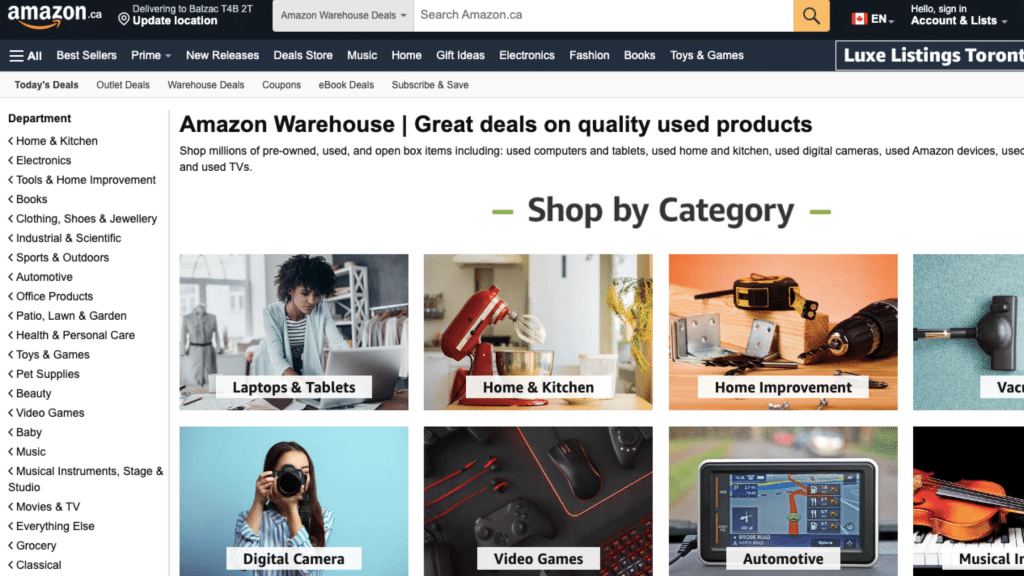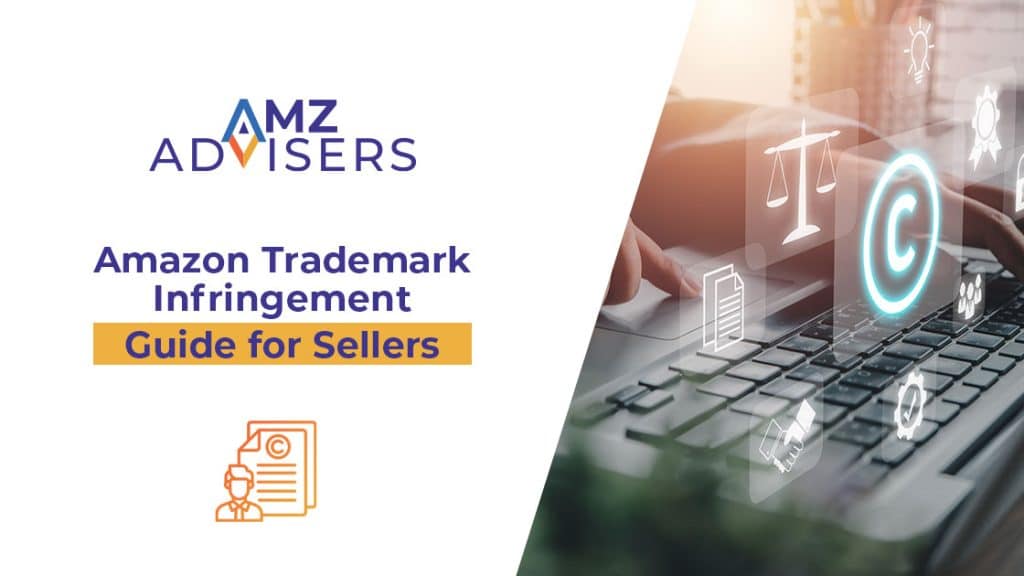Offerte di magazzino Amazon is a marketplace where shoppers can find discounted and refurbished items, appealing to those looking for good deals. However, if you’re a seller and see your product in this section, it might raise some questions.
So, what does Amazon Warehouse Deals mean for your brand, and how can you make the most of it? Let’s explore the basics of Amazon Warehouse, including why products end up there and what it means for sellers.
What is Amazon Warehouse Deals?
Offerte di magazzino is a unique Amazon store, specialized in offering discounted and open-box items.
Many items sold through Warehouse Deals are returned to Amazon for various reasons, such as buyer’s remorse, minor defects, or damaged packaging during transit. Thus, Warehouse products may include i rendimenti dei clienti, refurbished goods, and overstock items.
The inventory available on Amazon Warehouse Deals is based on the Amazon warehouse policy and it consists of products that have been returned by customers, used as display models or have damaged packaging.
These items are then inspected, tested, and graded by Amazon’s team of experts to ensure they meet specific quality standards before being listed for sale.
What are open-box items?
If it’s Amazon, “Open box” items are typically products that have been returned by customers. However, these returns are not due to any damage or defect in the product itself. Instead, customers might have returned the item for various reasons, such as changing their mind, finding a better price elsewhere, or realizing the product doesn’t meet their specific needs.
Amazon has strict guidelines for product condition, but “open box” does not mean the same thing in third-party stores. The term is actually used for computer games and software exclusively, where the item is no longer in its original packaging or case, but still functions perfectly.
Anything else that is marked as the open box can be anything that the seller defines it to be. The same standards for an item being sold by Amazon cannot be hoped for.
Contenuto relativo: Inside Amazon Trade-In
Can Amazon Warehouse Deals Sell My Products?
Sure. When Amazon gets a return that they classify as unsellable, it may not actually mean that they can’t sell it. They can’t sell it as one of your items because the packaging is damaged or it’s missing a part. However, Amazon can certainly repackage it and sell it as a Warehouse Deal.
Despite the confusion about this part of the Amazon website, it’s a cut-and-dry entity, part of the Amazon.com group that focuses on discount merchandise. It’s not surprising, since not all of the returns that Amazon gets go back into seller inventory.
What does Amazon Warehouse Deals mean for Sellers?
Amazon Warehouse Deals are separate from the Amazon Seller Central platform that brands typically use.
Unlike Seller Central, merchants cannot directly list their products in this section. Instead, when a customer returns an item that meets Amazon’s quality standards, the company retains the product and reimburses the buyer.
Should You Avoid Warehouse Deals?
There are a few clear reasons why you should be avoiding Offerte di magazzino Amazon.
Loss of Control Over Pricing and Brand Perception
When products are listed on Amazon Warehouse Deals, you lose control over pricing. Amazon often heavily discounts items in this section to clear their inventory.
As a result, the perceived value of your brand may diminish in the eyes of consumers. This can impact future sales and tarnish your reputation over time.
Increased Competition and Price Erosion
Products listed in Amazon Warehouse Deals are placed alongside similar items, which leads to more competition. This can trigger a race to lower prices, squeezing your profit margins.
Moreover, being part of a discounted section may devalue the product, making it less attractive to buyers who prefer new or full-priced items.
Limited Influence Over Product Condition and Customer Satisfaction
Items sold through Warehouse Deals may be labeled as used or refurbished, regardless of their actual condition. This classification could deter customers who are cautious about buying used items.
Additionally, sellers have minimal control over product quality and customer satisfaction, potentially resulting in negative reviews and returns.
Impact on Brand Loyalty and Long-Term Success:
While selling through Warehouse Deals may provide short-term relief for handling returns, it can harm brand loyalty in the long run.
Customers who purchase discounted products may perceive less value in the brand compared to those who buy at full price.
This erosion of brand loyalty can undermine future sales and hinder the establishment of long-term customer relationships.
Contenuto relativo: Amazon rinnovato
How to Deal with Amazon Warehouse Deals
There are two things that sellers should be focusing on when it comes to Offerte di magazzino Amazon. First, how to avoid products ending up there. And second, how to make sure that, if a product ends up there, you get a reimbursement.
Amazon may not actually dispose of customer returns in the way you think. If it’s sellable at a discount, it’s going to end up as a Warehouse Deal, so might be better to have the product returned to you.
If a product is lost or damaged in an Amazon warehouse, you may want to reconsider getting a reimbursement. Now, if it’s just the packaging that was damaged and the product still works, it will probably find its way to Amazon Warehouse Deals.
Imballaggio di alta qualità
- Thorough Inspection. Conduct a meticulous inspection on every returned item to ensure they meet quality standards. Check for any signs of damage, wear, or defects that could compromise customer satisfaction.
- Secure Packaging. Invest in robust packaging materials to safeguard your products during transit and storage. Opt for sturdy boxes, bubble wrap, and packing peanuts to minimize the risk of damage from handling and stacking.
- Proper Labeling. Label each package with essential information such as product name, FNSKU, and barcode. This facilitates easy identification and prevents mix-ups or confusion during inventory management.
- Resistente alle intemperie. Consider environmental factors that could affect your products during transit, such as humidity or temperature fluctuations. Use appropriate protective measures like moisture-absorbing packets or thermal insulation to mitigate potential damage.
- Documentazione. Track the packaging process with photos or videos to provide evidence of the condition of your products before shipment. Such documentation can serve as crucial evidence in case of disputes or reimbursement claims.
Gestione fatture
- Organized Record-Keeping. Maintain meticulous records of all invoices related to your inventory, including purchase receipts, shipping invoices, and transaction records. Organize these documents systematically for easy retrieval and reference.
- Real-Time Tracking. Keep track of all transactions and inventory movements in real-time using Amazon Seller Central or a software di gestione del magazzino. This enables you to monitor stock levels, sales performance, and financial transactions efficiently.
- Timely Reconciliation. Regularly reconcile your inventory with Amazon’s records to identify any discrepancies or missing items promptly. Addressing discrepancies promptly minimizes financial losses and ensures accurate accounting.
- Prompt Reimbursement Requests. In the event of damaged or lost inventory, promptly submit reimbursement requests to Amazon along with supporting documentation such as invoices and evidence of damage. Follow Amazon’s reimbursement procedures meticulously to expedite the reimbursement process.
- Persistence and Follow-Up. Maintain open communication with Amazon’s seller support team and provide additional evidence or clarification as needed. Persistence and proactive follow-up are key to securing timely reimbursement for eligible claims.
How to Protect Your Brand
Since the default in Seller central is to have the item reimbursed, you need to remove Amazon’s option to repackage your products. Opt out and have unfulfilled or damaged product returned directly to you.
You will have to pay for the cost of returns, but you will save a lot in opportunity cost down the line.
Figure out the value of lost Buy Box potential plus brand control and carefully compare that to return shipping. Remember, you can always resell those items on another marketplace where you retain control over the process and the customer experience. Last but not least, make sure to evaluate what is happening when an item gets back to you. If you are dealing with frequently returned items, then maybe it is time to change some things about either your product or how you present it to customers.
Contattaci oggi se hai bisogno di aiuto per aumentare le tue vendite su Amazon.
Autore






